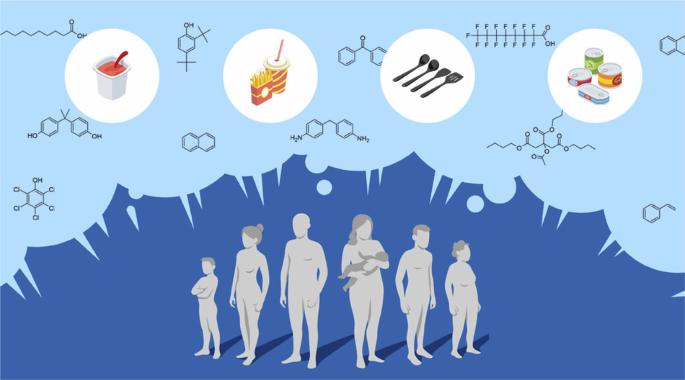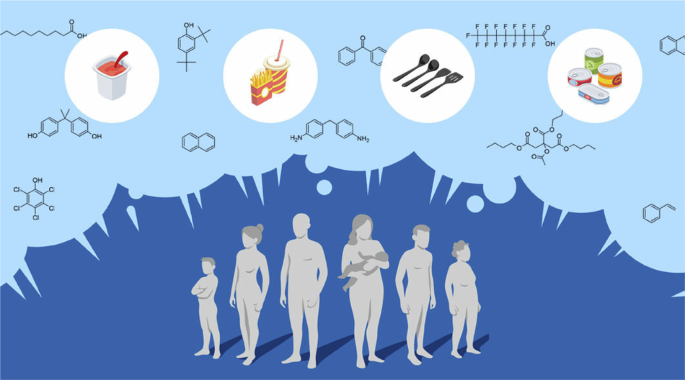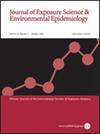Evidence for widespread human exposure to food contact chemicals
IF 4.7
3区 医学
Q2 ENVIRONMENTAL SCIENCES
Journal of Exposure Science and Environmental Epidemiology
Pub Date : 2024-09-17
DOI:10.1038/s41370-024-00718-2
引用次数: 0
Abstract
Over 1800 food contact chemicals (FCCs) are known to migrate from food contact articles used to store, process, package, and serve foodstuffs. Many of these FCCs have hazard properties of concern, and still others have never been tested for toxicity. Humans are known to be exposed to FCCs via foods, but the full extent of human exposure to all FCCs is unknown. To close this important knowledge gap, we conducted a systematic overview of FCCs that have been monitored and detected in human biomonitoring studies according to a previously published protocol. We first compared the more than 14,000 known FCCs to five biomonitoring programs and three metabolome/exposome databases. In a second step, we prioritized FCCs that have been frequently detected in food contact materials and systematically mapped the available evidence for their presence in humans. For 25% of the known FCCs (3601), we found evidence for their presence in humans. This includes 194 FCCs from human biomonitoring programs, with 80 of these having hazard properties of high concern. Of the 3528 FCCs included in metabolome/exposome databases, most are from the Blood Exposome Database. We found evidence for the presence in humans for 63 of the 175 prioritized FCCs included in the systematic evidence map, and 59 of the prioritized FCCs lack hazard data. Notwithstanding that there are also other sources of exposure for many FCCs, these data will help to prioritize FCCs of concern by linking information on migration and biomonitoring. Our results on FCCs monitored in humans are available as an interactive dashboard (FCChumon) to enable policymakers, public health researchers, and food industry decision-makers to make food contact materials and articles safer, reduce human exposure to hazardous FCCs and improve public health. We present systematically compiled evidence on human exposure to 3601 food contact chemicals (FCCs) and highlight FCCs that are of concern because of their known hazard properties. Further, we identify relevant data gaps for FCCs found in food contact materials and foods. This article improves the understanding of food contact materials’ contribution to chemical exposure for the human population and highlights opportunities for improving public health.


人类广泛接触食品接触化学品的证据
背景已知有 1800 多种食品接触化学品 (FCC) 会从用于储存、加工、包装和供应食品的食品接触物品中迁移。其中许多 FCC 具有令人担忧的危害特性,还有一些则从未进行过毒性测试。为了填补这一重要的知识空白,我们根据之前发布的协议,对在人体生物监测研究中监测和检测到的 FCC 进行了系统性概述。方法 我们首先将 14,000 多种已知 FCC 与五个生物监测计划和三个代谢组/表观组数据库进行了比较。第二步,我们对在食品接触材料中经常检测到的 FCC 进行了优先排序,并系统地绘制了这些 FCC 在人体中存在的现有证据图。结果在 25% 的已知 FCC(3601 种)中,我们找到了它们在人体中存在的证据。其中包括来自人体生物监测计划的 194 种 FCC,其中 80 种具有高度关注的危害特性。在代谢组/暴露组数据库收录的 3528 种 FCC 中,大部分来自血液暴露组数据库。我们发现,在系统证据图中列出的 175 种优先考虑的 FCCs 中,有 63 种存在于人体中,59 种优先考虑的 FCCs 缺乏危害数据。重要意义尽管许多 FCCs 还有其他暴露来源,但这些数据将迁移信息和生物监测信息联系起来,有助于优先考虑值得关注的 FCCs。我们在人体中监测到的催化还原剂结果以互动式仪表板(FCChumon)的形式提供,帮助政策制定者、公共卫生研究人员和食品行业决策者提高食品接触材料和物品的安全性,减少人体接触有害催化还原剂的机会,改善公众健康。此外,我们还指出了食品接触材料和食品中发现的 FCCs 的相关数据缺口。这篇文章加深了人们对食品接触材料造成人类化学暴露的了解,并强调了改善公众健康的机会。
本文章由计算机程序翻译,如有差异,请以英文原文为准。
求助全文
约1分钟内获得全文
求助全文
来源期刊
CiteScore
8.90
自引率
6.70%
发文量
93
审稿时长
3 months
期刊介绍:
Journal of Exposure Science and Environmental Epidemiology (JESEE) aims to be the premier and authoritative source of information on advances in exposure science for professionals in a wide range of environmental and public health disciplines.
JESEE publishes original peer-reviewed research presenting significant advances in exposure science and exposure analysis, including development and application of the latest technologies for measuring exposures, and innovative computational approaches for translating novel data streams to characterize and predict exposures. The types of papers published in the research section of JESEE are original research articles, translation studies, and correspondence. Reported results should further understanding of the relationship between environmental exposure and human health, describe evaluated novel exposure science tools, or demonstrate potential of exposure science to enable decisions and actions that promote and protect human health.

 求助内容:
求助内容: 应助结果提醒方式:
应助结果提醒方式:


